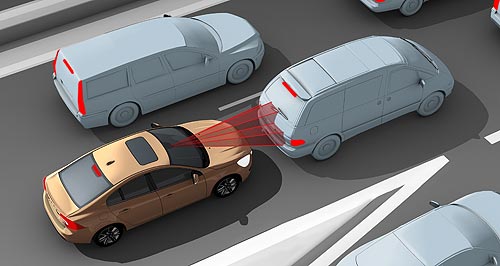Make / Model Search
News - VolvoVolvo safety systems get the thumbs upGrinding halt: Volvo's Pedestrian Detection system applys full-force braking when the car gets too close to a wayward walker. GoAuto puts Volvo’s bag of safety acronyms to the test at Eastern Creek raceway8 Aug 2011 SCANDINAVIAN car-maker Volvo makes no bones about its quest to make its cars as safe as possible, repeating its vision that nobody should be killed or seriously injured in one of its new vehicles by 2020. The brand’s City Safety technology is among an array of active safety features introduced to its newer models that are designed to help the car avoid a collision altogether. Cars fitted with the City Safety system have a laser sensor mounted to the interior mirror that monitors traffic ahead and can detect objects up to six metres in front of the bumper. The technology functions at speeds lower than 30km/h and automatically stops or slows the car if the driver fails to brake in time. Alongside City Safety, preventative systems such as Lane Departure Warning (LDW), Adaptive Cruise Control (ACC), Collision Warning with Full Auto Brake (CWAB), Queue Assist, Pedestrian Detection and Blind Spot Information System (BLIS) are available on the XC60, S60 and V60. Volvo Australia says 49.8 per cent of S60 and V60 buyers opt for the Driver Support Pack, which bundles this array of acronyms into a $4990 package.  Left: The Pedestrian detectiion system in action, image of camera mounted in front of rear-view mirror. Below: Diagram of Collision Warning with full automatic brake. Left: The Pedestrian detectiion system in action, image of camera mounted in front of rear-view mirror. Below: Diagram of Collision Warning with full automatic brake.GoAuto recently tested these various technologies in a batch of real-world simulations at Sydney’s Eastern Creek raceway and can report that, clunky nomenclature aside, each worked precisely as intended. We took to the circuit’s skidpan to try our hand at City Safety, driving at 30km/h in close proximity to a giant, moving inflatable bag attached to the side of another vehicle. When the car holding the bag slowed down, our test car automatically slowed as well, and it is easy to see how a system like this could be handy in peak-hour congestion. Driving at a giant inflatable car at speeds of around 25km/h and counter-intuitively avoiding the brakes (to simulate inattention) failed to trick the system, which pulled the car up with confidence time and time again. The skidpan was also decked out to test the tricky pedestrian detection system, which successfully braked the car if we failed to slow down in time to avoid an inflatable dummy. Previous footage showing a V60 fitted with the system striking an inflatable mock pedestrian was explained as being a result of failure to fit a special strip to the mock-person. The system works by detecting mass, and the air-filled dummy is not an accurate simulation of a flesh-and-blood human without this strip. We then took to the track to test the Adaptive Cruise Control (ACC) and Blind Spot Information (BLIS) systems. The system is much like the adaptive cruise control that can be found as either standard or as an option in a number of other cars such as the all-new Ford Focus Titanium. The cruise control, activated by a button on the steering wheel, uses a radar sensor to measure the distance between the car and the vehicle ahead, and adjusts the speed to retain one of five optional intervals programmed by the driver. The Queue Assist system, meanwhile, brings the car to a complete stop from low speeds when it senses a stationary object in its path. Our S60 test car successfully mirrored the pace of a lead vehicle, finally coming to a dead halt short of its bumper. Tapping the cruise activation button on the wheel got us back running again at our previous speed. The BLIS system, meanwhile, used a camera to monitor the car’s blind spots and lit up a section of the inside of the A-pillar to alert us to the presence of a vehicle nearby. While it could be said that the need for systems like this would be negated by simple improvements in driver inattention, it was harder to argue the effectiveness of each system in situations that require them. Indeed, the City Safety automatic braking system has been shown to prevent more than a quarter of low-speed commuter crashes, according to a recent study from the United States. An analysis of insurance claims by the Highway Loss Data Institute found that the Swedish company’s XC60 SUV, which comes standard with City Safety, is involved in fewer low-speed crashes than comparable models. The Institute – a research organisation funded by the North American car insurance industry – said payouts for “at-fault drivers” were 27 per cent less frequent for the XC60 than other mid-sized luxury SUVs. Institute president Adrian Lund said this was his organisation’s first real look at an advanced crash avoidance system, and described the findings as encouraging. “City Safety is helping XC60 drivers avoid the kinds of front-to-rear, low-speed crashes that frequently happen on congested roads,” he said. While Mr Lund acknowledged that the findings may have been influenced by different driving styles between XC60 owners and owners of other comparable models, he said “the pattern of results strongly indicates that City Safety is preventing low-speed crashes and reducing insurance costs.”  Read more |
Click to shareVolvo articlesResearch Volvo Motor industry news |











Facebook Twitter Instagram